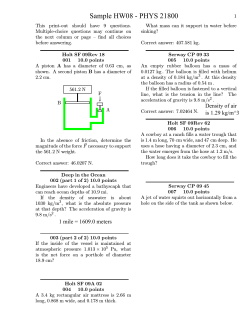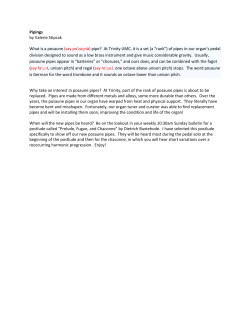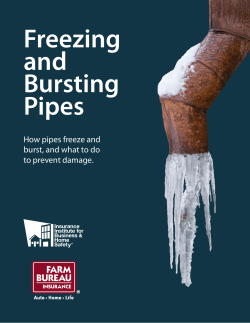
1. General Short Answer Questions 1 point each a.
Question #1 must be completed by all students 1. General Short Answer Questions a. 1 point each i. How much energy is stored in a spring who’s k = 30 N/m and amplitude is 15 cm? 0.338 J What is the depth of fresh water, when the absolute pressure is 8930300 Pa? 900 m Water flows at 4.0 m/s in a 6.0 cm diameter horizontal pipe. Later that pipe breaks into two smaller horizontal pipes of 3.5 and 1.75 cm diameters each. If the velocity in the 3.5 cm pipe is 7.0 m/s, then what is the velocity in the other? 19 m/s The diameters of the input and output pistons of a hydraulic car hoist are 70 and 25 cm respectively. What is the minimum holding force on the input piston that will support a 3000 kg ? 382 kg or 3753 N The gauge pressure in a car tire is 154 kPa at 15.0 °C. What is the new gauge pressure when the tire warms up to 32.0 °C? 169 kPa What is the length of a pendulum that has a period of one second on the moon (g moon = 1/6(g earth))? 4.1 cm What is the fundamental frequency of a air column that supports standing waves at the following two successive resonance frequencies: 1150 Hz and 1250 Hz? 50 Hz 9 -6 -1 What is the stress in a steel wire (Y = 200 x 10 Pa, " = 12 x 10 °C ) that is stretched taught and is 10 m at 25 °C then is cooled to -100 °C? 300 MPa What is the frequency of a 5.43 D light wave in a glass block, n = 1.5? j. What is the speed of sound in steel (Y = 200 x 109 Pa, s.g. = 7.88)? b. c. d. e. f. g. h. 5037 m/s 1 Choose any FIVE of the remaining questions to complete 2. Joe (m = 80 kg) ties bungie cords to his legs and takes the great dive. Initially the cords are 4.0 metres long, have a cross sectional area of 3.14 x 10-4 m2, and an elastic modulus of 90 x 106 Pa a. Show the effective spring constant is 7065 N/m. b. What is the maximum stretch in the cord assuming that Joe falls freely for 4.0 metres before the cord begins to stretch? (Quadratic) [1.06 m] c. What is the force in the cord at the maximum stretch? d. After Joe hits the bottom the first time he begins a decaying SHO. What is the frequency of the SHO? [0.017 Hz] e. Using the maximum force and the safety factor of 6 determine the cord’s ultimate strength. [143.1 MPa] a. A shipwreck diver, in the Indian Ocean (s.g. = 1.025) attaches an air filled balloon to a 4.0 kg brass (s.g. = 3.5 )lost artifact. The balloon has a mass of 1.2 kg but the air contained within is negiligable. [7488.9 N] 3. b. i. What is the apparent weight of the artifact? [27.75 N] ii. He releases the balloon and it accelerates to the surface at 1.25 m/s2. What is the volume of the balloon? [0.00326 m3] A water purification plant has pipes at the ground floor. These pipes have a flow rate of 4.0 L/s and diameter of 12.0 cm. 80 metres above those pipes are smaller pipes with an open faucet. The faucet diameter is 1.0 cm. i. ii. iii. What is the speed in the lower pipe? What is the speed at the faucet? What is the absolute pressure in the lower pipe? 2 [0.35 m/s] [51 m/s] [2.18 MPa] 4. A rain forest display at the Winnipeg Zoo has a volume on 700 m3, and is supposed to be at a humidity of 84%. The display and outdoor temperature are 30.0 °C a. b. Outside the humidity is 53%. What is the dew point? [a little over 20°C] How many moles of water vapour are in the room before the humidifier is activated? [624.4 mol] c. How many moles of water vapour must be added to bring the room up to the desired 84% humidity? [365.1 mol] d. Realistically the curators would also change the temperature of the room to maintain the desired humidity. What would you do, raise or lower the room temperature? [Raising the temperature increases the amount of vapour the air can hold thus the relative humidity.] 5. A 410 g block of aluminum is taken from an oven and placed in a 130 g steel container with 350 g of water initially at 30°C. The result is that when equilibrium is reached only 330 g of water remain in the cup. a. b. c. 6. A standing wave pattern which vibrates at 1500 Hz exists on a 0.44 m long string. The next higher frequency that will produce a harmonic standing wave patten on the same string is 1800 Hz. The linear density of the string is 0.003 kg/m. a. b. c. d. 7. Explain what happened to the missing 20 g of water. [it vaporized] Deduce what the final equilibrium temperature must be. [must be 100°C] What was the initial temperature of the aluminum when it came from the oven? [511°C] What is the mass of the string? [1.32 grams] What is the frequency of the fundamental standing wave pattern on this string? [300Hz] Which harmonic numbers correspond to 1500 Hz and 1800 Hz? Sketch both of these patterns? [5th and 6th ] What is the tension in the string? [209 N] A toy airplane is tethered to a string attached to the ceiling and flies around in circles. The motor of the plane appears to make a sound which varies from 450 Hz to 470 Hz due to the fact that as the plane moves around its circular path it is sometimes moving toward you and sometimes moving away. a. b. c. Determine the speed of the plane (assuming air temperature is 15°C) [7.4 m/s] Determine the actual frequency produced by the plane’s motor [459.79 Hz] How many decibels of loudness will you hear from the toy plane when it is 7 m away given that it is 25 dB when it is 5 m away? [22.1 dB] 3 Physics 1200 Formula and Data sheet F = kx (may be detached carefully from exam) R.H . = PEs = 12 kx 2 = 12 Fx strain = v. p. *100 s. p. KE = 12 mv 2 = 23 kT ∆l ∆ V = = α∆T l0 V0 U = 23 NkT F A stress Y= strain ∆P B=− strain Ult.Strength S .F . = stress stress = vrms T ( K ) = T ( o C ) + 273 R= 1 T m l = 2π T = 2π k g ω = 2π f Patm = 101.3kPa = 1atm = 760torr Pin = Pout vmax = A k m FB = Fg − Fg ' = ρ fluid gVdisplaced ∆V ∆t Ain vin = Aout vout V .R. = v= P1 + 1 ρ v1 + ρ gh1 = P2 + 1 ρ v2 + ρ gh2 2 2 v = 2 gh 2 2 µ= λ dist T time FT Y B γ kT = = = m µ ρ ρ v=λf = V .R.in = V .R.out = m = ρA l vsound = 331.5 + 0.6T ∆L = α L0 ∆T ∆A ≈ 2α A0 ∆T ∆V ≈ 3αV0 ∆T = β V0 ∆T sin θ i sin θ r = vi vr sin θ i λi Q = mc∆T Q = mL = sin θ r λr P 4π r 2 2 I1 r2 = 2 I 2 r1 I= 1u = 1.66 x10−27 kg R = 8.315( J /(mol * K )) R = 0.0821((atm * L) /(mol * K )) k = 1.38 x10−23 ( J / K ) N a = 6.022 x10 mol −1 β = 10log I −12 1 10 × γ = 1.4(air ) = 1.67(ideal ) 4 m N n= = MM N a λ= PV = nRT PV = NkT c v ni sin θ i = nr sin θ r n= T ( o F ) = 95 T ( o C ) + 32 f = 4 L n 2 λ= L n f n = nf1 vsound ± vobserver vsound ∓ vsource c = 3.0 × 108 m / s 3kT = m T ( o C ) = 95 (T (o F ) − 32) m ρ = = 1000* S .G. V F P = = ρ gh A Pabs = Patm + Pgauge 23 f ' = f0 l k Q A∆T = ∆t ΣR Q = εσ A(T24 − T14 ) ∆t σ = 5.67 x10−8 J/(s*m 2 *K 4 ) T (°C) S.V.P. (Pa) -50 4 -10 260 0 611 5 872 10 1230 15 1710 20 2330 25 3140 30 4240 40 7370 50 12300 60 19900 70 31200 80 47300 90 70100 100 101000 120 199000 150 476000 5
© Copyright 2025





















